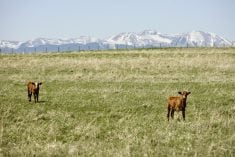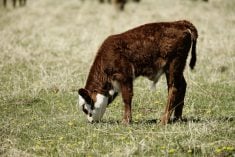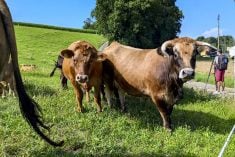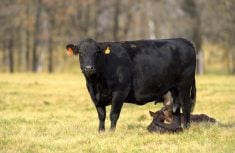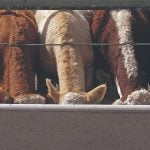Though the practice of preconditioning calves is relatively well known, not everyone agrees on the definition of the term.
Confusion over what preconditioning entails may be partly to blame for reports of inconsistent returns on investment, says one researcher.
“To me, it’s way more than just optimizing a vaccination protocol,” says Dr. Karin Orsel, veterinary epidemiologist and professor at the University of Calgary’s faculty of veterinary medicine (UCVM).
“It is thinking about everything we do on the ranch that is either painful or stressful to the animal, and how can we do that in the best way to keep the animal healthy.”
Read Also

Canadian Beef Check-Off Agency reports on investments and activities
The check-off agency’s work behind the scenes is what ensures cattle check-off dollars are invested wisely, accounted for transparently and deliver measurable value back to producers and importers.
By reducing stress related to weaning, transport and adapting to feedlots, preconditioning decreases the likelihood of bovine respiratory disease (BRD). Preconditioning involves weaning calves using low-stress methods around 45 days before shipment; conducting all health protocols with proper timing, handling and pain mitigation; plus helping calves adapt to bunk feeding.
“It’s the principle of making sure that the immune system can work to its maximum capacity,” she says. That means vaccinating at the right time and giving the right dose. It also means spreading out stressful events and reducing stress on calves as much as possible.
However, some producers are reluctant to precondition because they don’t see a return on investment when selling calves. Orsel suspects the ambiguous definition of preconditioning doesn’t help.
“Certain animals might just have gotten an extra vaccination but still had a lot of stressful events happening to them on the day before they got on the truck, and then in the feedlot would not outperform (conventionally weaned calves). So if producers don’t buy in, it’s mostly because the people who make the investments don’t necessarily see the return.”
Diving deep into preconditioning
Though past studies have proven a pen of preconditioned calves will outperform those that were conventionally weaned, numbers can create a challenge. “I think what the challenge was for a lot of producers is that there weren’t enough preconditioned animals to fill pens based on weight and sex,” says Orsel. “Preconditioned animals would be mixed in with conventional animals, and they are not convinced that they would out-perform.”
Whether or not commingling reduces the performance and disease prevention benefits of preconditioning is one of the questions being explored in a multidisciplinary study at UCVM. Orsel is the principal investigator, taking a deep dive into how preconditioning affects the health, welfare and performance of feeder calves.

“Dealing with BRD in the feedlot is still one of our biggest challenges, and I don’t think the solution lies in finding a new antimicrobial or giving more antimicrobials or combining antimicrobials. I think our solution sits in becoming more creative,” she says.
Low-stress, fenceline weaning was used for 250 calves raised at UCVM’s W.A. Ranches. “We really tried to do the preconditioning according to the book with vaccination protocol, with castration at the preferred age with the preferred method with pain mitigation,” says Orsel.
Post-weaning, calves stayed on the ranch for 40 days of feeding, getting used to eating from feed bunks and drinking from waterers.
After purchasing another 250 calves, all conventionally weaned, the researchers sorted the two groups of calves into feedlot pens — one pen with just preconditioned calves, one with just conventionally weaned calves and three commingling the calves in different percentages — to compare performance and health.
For example, the researchers took hair samples from all 500 calves in the trial, which will be analyzed for cortisol to determine how much stress the animals experienced before arriving at the feedlot. They will then examine individual calf performance in relation to stress levels.
Orsel and her students are examining the morbidity and mortality data, while UCVM’s Ed Pajor is analyzing the calves’ behaviour and welfare and Frank van der Meer is studying the respiratory microbiome. Kathy Larson of the University of Saskatchewan and Henry An of the University of Alberta are focusing on the economic analysis of this trial. Other collaborators include microbiologist Trevor Alexander of Agriculture and Agri-Food Canada Lethbridge, and nutrition and livestock feed researcher Sean Thompson of Olds College.
Although the data was collected in December 2020, challenges due to COVID-19 slowed the research process, Orsel reports. Analysis is ongoing, though they have some early results.
“We started analyzing the feed intake behaviour, and those animals, when they arrive at the feedlot, they know how to eat from a bunk. So on the day of arrival, they immediately start feeding really well, where the auction calves really needed up to four days before they started picking up.”
The researchers have also looked at the antibody levels within the calves’ blood. “We know that all but two out of 250 animals had high protected titers upon arrival at the feedlot, where the auction calves, easily up to 40 to 60 per cent were below, so they would come in with low antibody titers.”
Orsel anticipates full results will be ready in 2022. “There’s still way more to come, but the first impression is that our animals were way better prepared for life in the feedlot than the average auction calf,” she says.
“Out of 250 calves last summer we treated two for summer pneumonia. I haven’t analyzed the data, but I can tell you our animals were healthy as can be because that is a low number.”
Economic research needed
Studies in the U.S. have shown that “feedlots buying preconditioned calves can benefit from improved rates of gain and feed efficiency, lower treatment rates and death loss and lower cost of gain,” according to the Beef Cattle Research Council’s webpage on preconditioning, which also mentions the benefits of heavier sale weights and possible premiums to cow-calf producers.
Despite this, Orsel believes there is more to research on the economics of preconditioning, particularly to understand producers’ motivations and barriers to the practice. This study’s economic analysis will examine where specifically producers are willing to invest in this.
There’s more to this than price, Orsel adds. “I think that return is not just in the dollars of a weaned calf in the hundredweight price; I think it should also be in the health of the calf at the ranch,” she says, noting that the cost and benefits extend into time, labour and necessary facilities.
For example, the staff at W.A. Ranches reported how easy these practices made it to handle the cows and calves during and after weaning. “The cows weren’t bawling for days. The cows were just fine having the calves on the other side of the fence. So there were a lot of things that are harder to really put a dollar figure on, but they have to do with pleasure in work, with ease of work, with pride in what you’re doing. And I think that’s why the people that do preconditioning do it — it’s because there is more than just that hard dollar on the hundredweight,” she says.
Orsel and her colleagues also plan to study how preconditioning affects replacement calves, with the return on investment staying on the cow-calf operation.
“I think the most important thing is that we all care about health and well-being of our animals,” she says. “Health and well-being is core and centre to preconditioning.”





